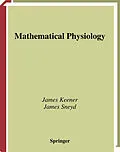Mathematical Physiology provides an introduction into physiology using the tools and perspectives of mathematical modeling and analysis. It describes ways in which mathematical theory may be used to give insights into physiological questions and how physiological questions can in turn lead to new mathematical problems.
The book is divided into two parts, the first dealing with the fundamental principles of cell physiology, and the second with the physiology of systems. In the first part, after an introduction to basic biochemistry and enzyme reactions, the authors discuss volume control, the membrane potential, ionic flow through channels, excitability, calcium dynamics, and electrical bursting. This first part concludes with spatial aspects such as a synaptic transmission, gap junctions, the linear cable equation, nonlinear wave propagation in neurons, and calcium waves.
In the second part, the human body is studied piece by piece, beginning with an introduction to electrocardiology, followed by the physiology of the circulatory system, blood, muscle, hormones, and kidneys. Finally, the authors examine the digestive system and the visual system, ending with the inner ear.
This book will be of interest to researchers, to graduate students and advanced undergraduate students in applied mathematics who wish to learn how to build and analyze mathematical models and to become familiar with new areas of application, as well as to physiologists interested in learning about theoretical approaches to their work.
The inclusion of numerous exercises and models could be used to add further interest and challenge to traditional courses taught by applied mathematicians, bioengineers, and physiologists.
Klappentext
Divided into two parts, the book begins with a pedagogical presentation of some of the basic theory, with chapters on biochemical reactions, diffusion, excitability, wave propagation and cellular homeostasis. The second, more extensive part discusses particular physiological systems, with chapters on calcium dynamics, bursting oscillations and secretion, cardiac cells, muscles, intercellular communication, the circulatory system, the immune system, wound healing, the respiratory system, the visual system, hormone physiology, renal physiology, digestion, the visual system and hearing.
Inhalt
Preface & Acknowledgments * I Cellular Physiology * 1 Biochemical Reactions * 2 Cellular Homeostasis * 3 Membrane Ion Channels * 4 Excitability * 5 Calcium Dynamics * 6 Bursting Electrical Activity * 7 Intercellular Communication * 8 Passive Electrical Flow in Neurons * 9 Nonlinear Wave Propagation * 10 Wave Propagation in Higher Dimensions * 11 Cardiac Propagation * 12 Calcium Waves * 13 Regulation of Cell Function * II Systems Physiology * 14 Cardiac Rhythmicity * 15 The Circulatory System * 16 Blood * 17 Respiration * 18 Muscle * 19 Hormone Physiology * 20 Renal Physiology * 21 The Gastrointestinal System * 22 The Retina and Vision * 23 The Inner Ear * Appendix: units and physical constants * References * Index
